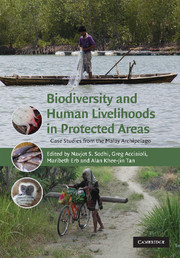Book contents
- Frontmatter
- Contents
- List of contributors
- Acknowledgements
- 1 General introduction
- Part I Conservation needs and priorities
- Part II Conservation with and against people(s)
- 11 Introduction to Part II
- 12 Collaboration, conservation, and community: a conversation between Suraya Afiff and Celia Lowe
- 13 Hands off, hands on: communities and the management of national parks in Indonesia
- 14 Conservation and conflict in Komodo National Park
- 15 Another way to live: developing a programme for local people around Tanjung Puting National Park, Central Kalimantan
- 16 For the people or for the trees? A case study of violence and conservation in Ruteng Nature Recreation Park
- 17 Seas of discontent: conflicting knowledge paradigms within Indonesia's marine environmental arena
- 18 Strategy and subjectivity in co-management of the Lore Lindu National Park (Central Sulawesi, Indonesia)
- 19 Indigenous peoples and parks in Malaysia: issues and questions
- 20 Protecting Chek Jawa: the politics of conservation and memory at the edge of a nation
- 21 Integrating conservation and community participation in protected-area development in Brunei Darussalam
- 22 Conclusion to Part II
- Part III Legal and governance frameworks for conservation
- 29 General conclusion
- Index
- References
19 - Indigenous peoples and parks in Malaysia: issues and questions
from Part II - Conservation with and against people(s)
Published online by Cambridge University Press: 12 November 2009
- Frontmatter
- Contents
- List of contributors
- Acknowledgements
- 1 General introduction
- Part I Conservation needs and priorities
- Part II Conservation with and against people(s)
- 11 Introduction to Part II
- 12 Collaboration, conservation, and community: a conversation between Suraya Afiff and Celia Lowe
- 13 Hands off, hands on: communities and the management of national parks in Indonesia
- 14 Conservation and conflict in Komodo National Park
- 15 Another way to live: developing a programme for local people around Tanjung Puting National Park, Central Kalimantan
- 16 For the people or for the trees? A case study of violence and conservation in Ruteng Nature Recreation Park
- 17 Seas of discontent: conflicting knowledge paradigms within Indonesia's marine environmental arena
- 18 Strategy and subjectivity in co-management of the Lore Lindu National Park (Central Sulawesi, Indonesia)
- 19 Indigenous peoples and parks in Malaysia: issues and questions
- 20 Protecting Chek Jawa: the politics of conservation and memory at the edge of a nation
- 21 Integrating conservation and community participation in protected-area development in Brunei Darussalam
- 22 Conclusion to Part II
- Part III Legal and governance frameworks for conservation
- 29 General conclusion
- Index
- References
Summary
Introduction
This chapter seeks to describe the relationship between indigenous peoples and several protected areas in Malaysia, namely Krau Wildlife Reserve, Taman Negara National Park, Endau Rompin National Park, Kinabalu National Park and Gunung Mulu National Park. These protected areas were chosen because they all illustrate various aspects of the relationship between protected areas and indigenous people. Krau Wildlife Refuge in Pahang is used by groups of Chewong and Jah Hut. These two groups live outside the park, but maintain a certain level of traditional ownership rights to the reserve. Taman Negara, covering parts of Pahang, Kelantan and Terenganu, is the home of a group of the Batek Negrito people. This case study describes the relationship of grudging tolerance on the part of the park administration towards a small and truly nomadic group of indigenous people. Endau Rompin National Park in Johor shows how indigenous people are currently employed in parks and conservation in Malaysia. The description of Gunung Mulu provides a portrait of the Eastern Penan, another hunter-gather group numbering about 400, who live in and have customary access rights to the park. This instance also reveals how the Sarawak Forestry Department (SFD) has handled an indigenous population residing within a protected area. Lastly, Kinabalu Park illustrates the treatment of indigenous people in the state of Sabah, in which indigenous groups have far more influence than any of the other states of Malaysia.
- Type
- Chapter
- Information
- Biodiversity and Human Livelihoods in Protected AreasCase Studies from the Malay Archipelago, pp. 289 - 310Publisher: Cambridge University PressPrint publication year: 2007



